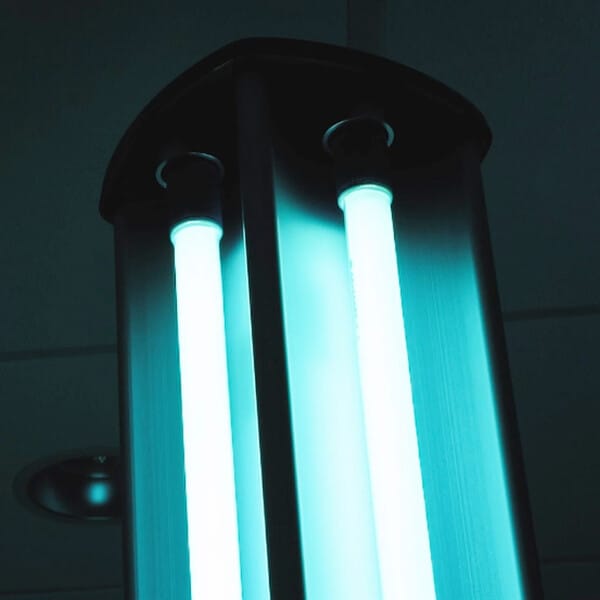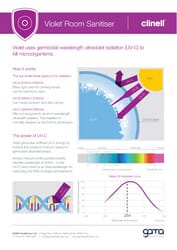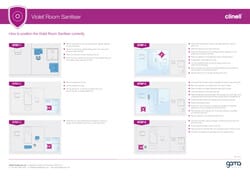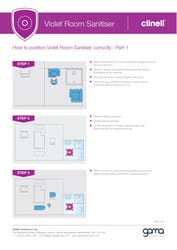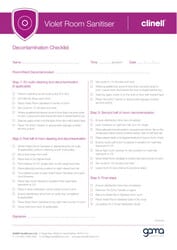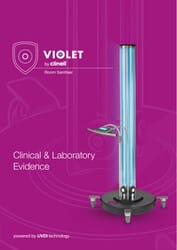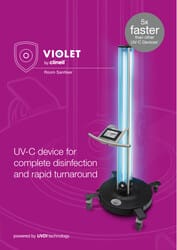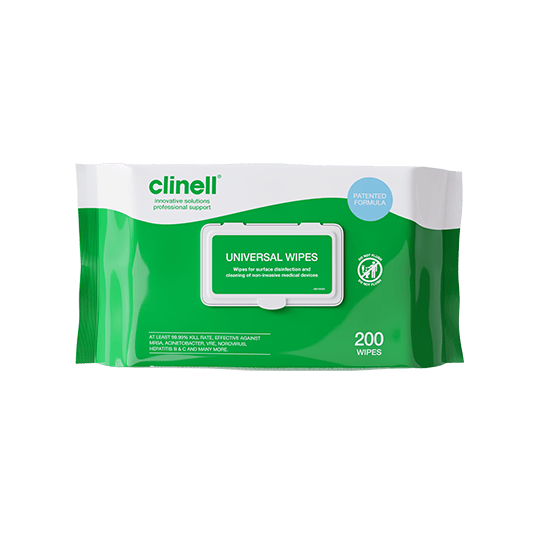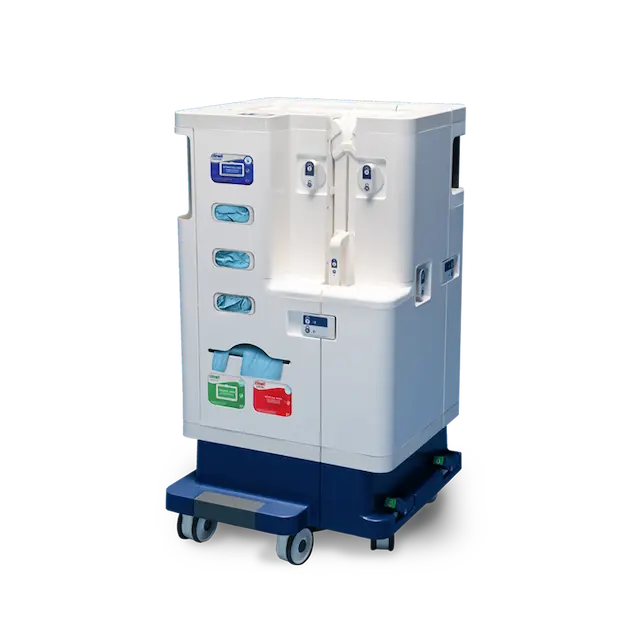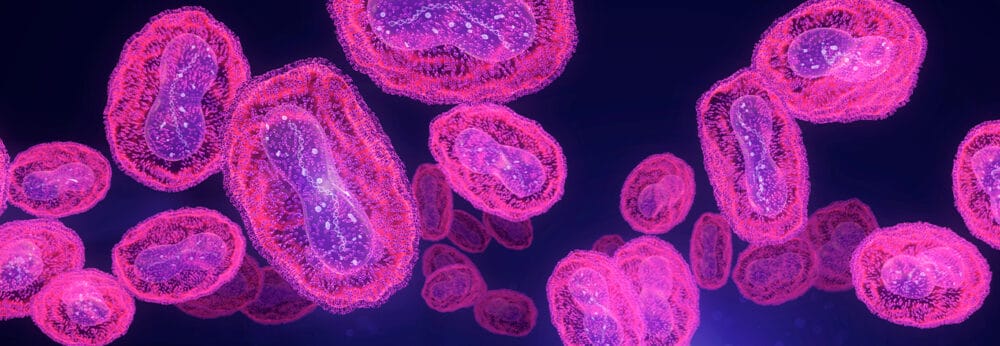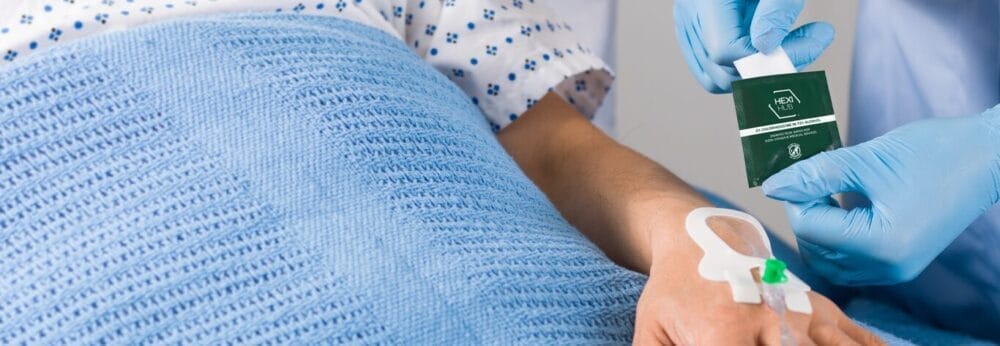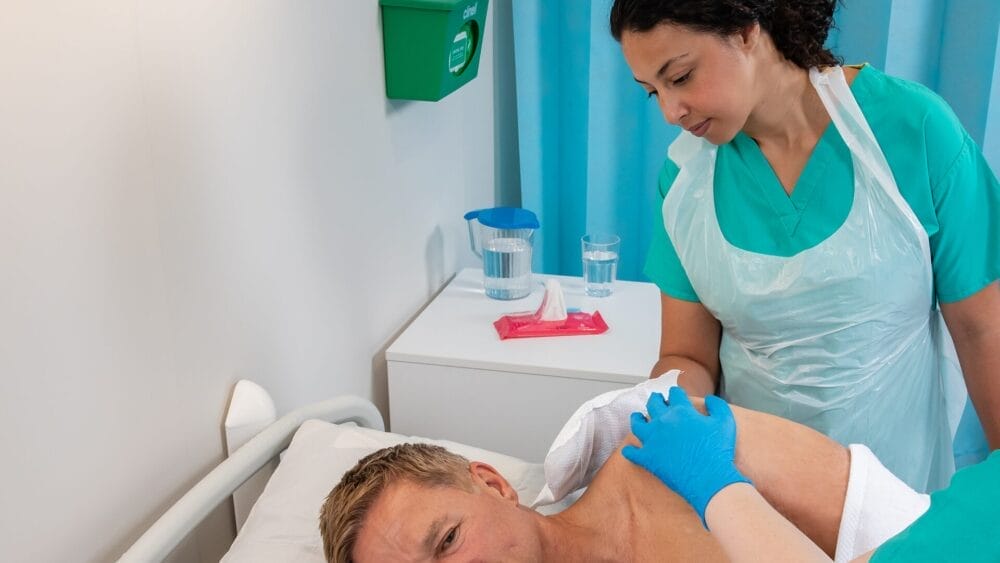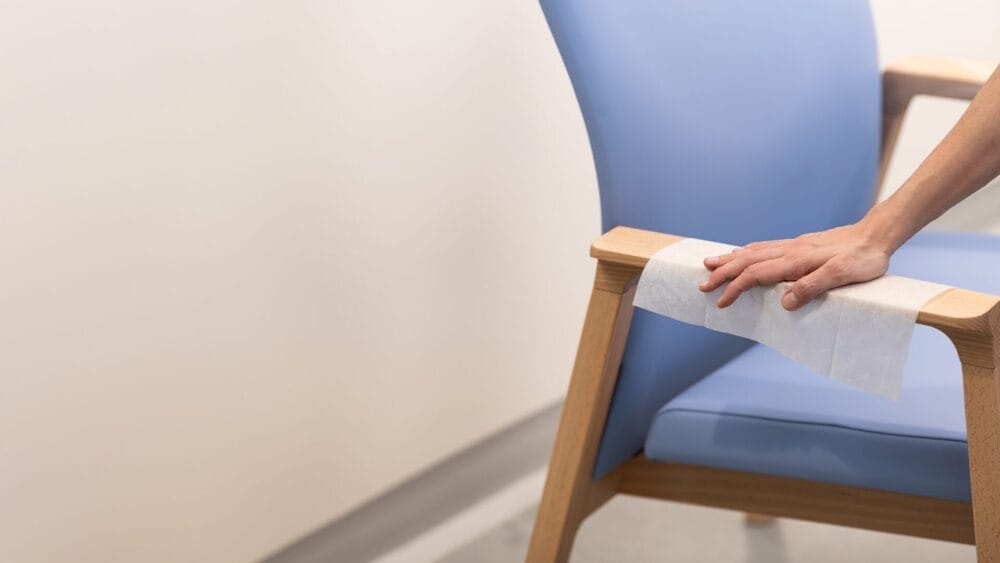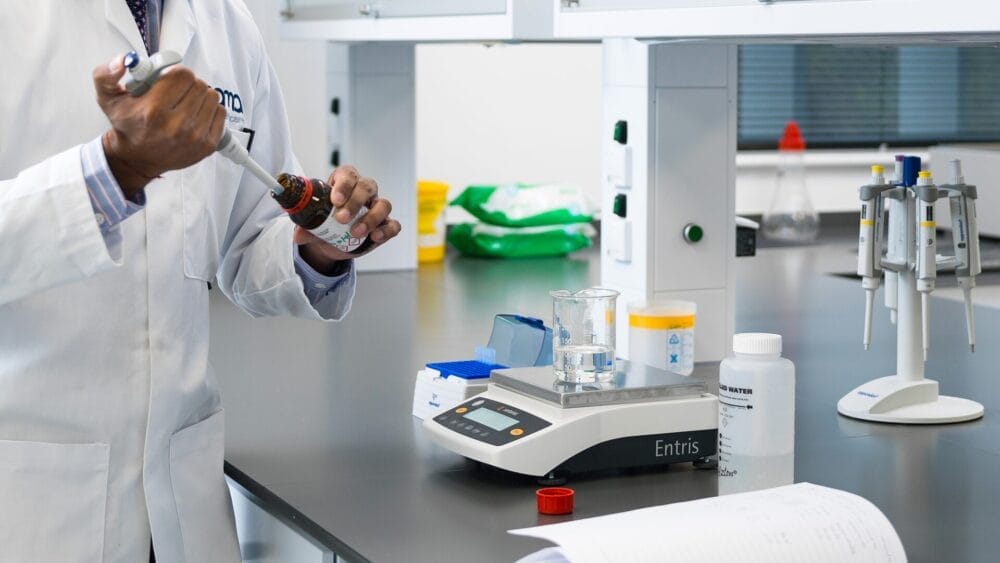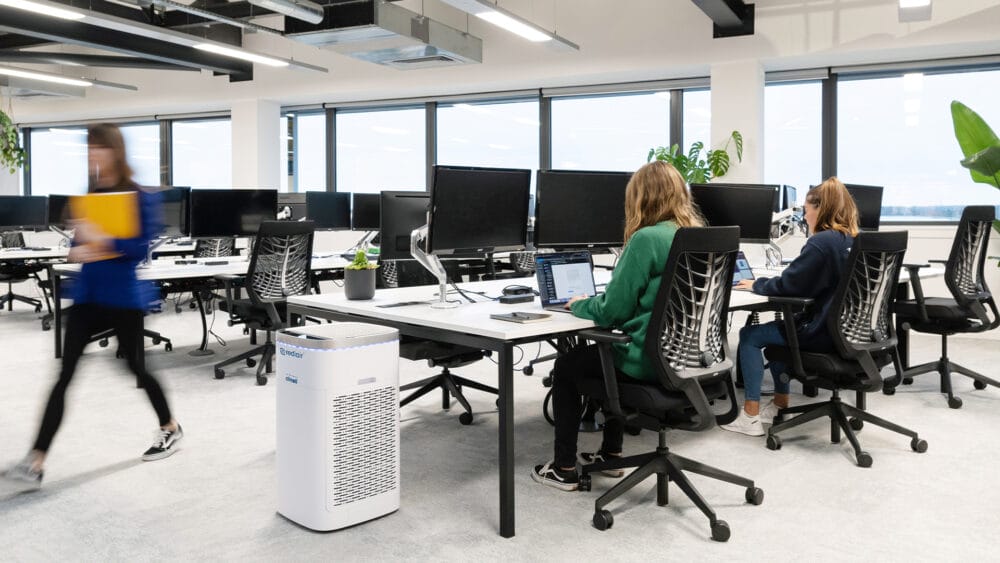Violet Room Sanitiser
UV-C device for complete disinfection and rapid turnaround. 3x faster turnaround than HPV. Proven efficacy against human coronaviruses, MRSA and C. diff.
Ideal addition to manual cleaning & disinfection. Violet is designed for effective, affordable and safe environmental disinfection. Powered by UVDI technology, Violet emits UV-C radiation at a specific antimicrobial wavelength that is proven to kill >99.99% of C. difficile spores and MRSA in minutes.
Product code: CUV360
NHSSC: MFB1144
Complete disinfection with Violet Room Sanitiser

POWERFUL ULTRAVIOLET TECHNOLOGY
The power of four 1.6m UV-C lamps that are 7x more powerful than competing lamps, at an affordable price.

COMPLETE DISINFECTION & RAPID TURNAROUND
Proven to give 3x faster turnaround than HPV and be 5x faster at killing C. difficile than other UV-C devices.

CLINICALLY PROVEN TO KILL CORONAVIRUS
Kills >99.99% of microorganisms including C. difficile spores, MRSA and human coronavirus.

VERIFIED DOSE FOR ASSURED DISINFECTION
Be confident in your results, accurately measure UV-C dose with the UVCense Bluetooth Dosimeter.
Ultraviolet: How does ultraviolet radiation (UV-C) work?
UV-C is a type of ultraviolet radition. At specific wavelengths, UV-C can kill single cell microorganisms. Absorbed into DNA, UV-C causes irregular molecular interactions that prevents the microorganism from reproducing, killing the cell and preventing further infection.
Violet emits UV-C at 254nm, this is ideal for killing microorganisms living on surfaces.
Ultraviolet: Should I use UV-C as well as routine cleaning & disinfection?
Ideally, yes. No-touch techniques, including UV-C technologies have been developed to improve disinfection efforts, reduce surface contamination and therefore HCAIs.
In the UK, the Joint Healthcare Infection Society (HIS) and Infection Prevention Society (IPS) guidelines recommend using UV-C as an additional measure to terminal cleaning for the prevention and control of HCAI-causing microorganisms such as MRSA.
Efficacy: Is Violet effective against COVID-19?
Yes, Violet has proven efficacy against human coronaviruses. Testing by a third party laboratory shows that Violet kills >99.99% of human coronaviruses up to 8 feet away in as little as 5 minutes.
COVID-19 is a disease caused by 'SARS-CoV-2', a member of the human coronavirus family. Like many other single cell microorganisms, coronaviruses are highly susceptible to UV-C.
Efficacy: What microorganisms is Violet effective against?
The majority of microorganisms are highly susceptible to UV-C. Violet has proven efficacy against key hospital pathogens including MRSA, C. diff, human coronavirus, CRE, MDROs and more, validated by third-party laboratories.
Compatibility: Can I use Violet on any surface?
Violet has no known surface compatibility issues when used as directed. UV-C degradation testing has been conducted on a wide range of materials commonly found in hospital settings. It found that no damage was caused upon exposure to UV-C.
Efficacy: How can I verify the UV-C dose delivered by Violet?
The UVCense Bluetooth Dosimeter provides laboratory grade performance for highly accurate UV-C measurements. Tailored to specifically capture 254nm wavelength UV-C radiation generated by Violet, the UVCense dosimeter can confirm whether a sufficient antimicrobial UV-C dose has reached the targeted surface.
Time: How long does Violet take to operate?
The recommendation for a hospital room is 2x 10 minute cycles in a side room, with the bed as the focal point. An additional 10 minute cycle is required for en-suite bathrooms. The room is ready to use as soon as the cycle has finished.
Efficacy: Are there any clinical studies supporting the use of UV-C and reduction in HCAIs?
For a full list of clinical studies, please see our Violet Evidence Brochure under the ‘Resources’ tab.
Safety: What safety features does Violet have to ensure people aren’t exposed to UV-C radiation?
• There are 4 infrared motion sensors on the base which prevent operation if movement is detected in the room
• The device won’t start if people are present in the room
• The case doubles as a physical barrier to prevent entry to the room if Violet is in use
• The machine uses polymer encapsulated bulbs which help to prevent bulb breakages
• The machine has a remote control operation with an emergency shut off option
Safety: Do the doors need to be taped over when the machine is running?
It is not essential to tape over doors (unless there is a gap >1cm), but this can be done as an extra precaution to stop people entering the room.
Safety: What about ventilation?
No gas or toxic compounds are produced during a cycle, so ventilation and fire alarms do not need to be sealed or capped.
Safety: Is the machine heavy?
Violet weights 40kg. The weight is evenly distributed across four wheels, making it easy to manoeuvre.
UV-C disinfection with Violet by Clinell is faster (20 min) in comparison with HPV (4 hours). We employ it for bacterial or viral infections including with MRSA or SARS-CoV-2.
EMMA JOBBINS, FACILITIES MANAGER, GRANGE UNIVERSITY HOSPITAL
Contact us for more information
We’d love to show you how Violet works in person. If you’d like a demonstration of Violet – including advice about how you could implement UV-C room sanitisation in your organisation – get in touch using the form.

Recommended for you
Latest
Norovirus: Understanding its transmission and prevention in the UK
Introduction Norovirus is recognised as the leading cause of viral gastroenteritis…
Clean Between to Reduce Healthcare-Associated Infections
Healthcare-associated infections (HAIs) are a significant concern for healthcare facilities…
Mpox: emergence of a new threat
A new threat related to mpox is emerging, in the…
Wiping away infections – the CLEEN way!
Cleaning shared medical equipment with a disinfectant wipe at least…
Embracing sustainability and cost savings: The journey of Clinell Indicator Notes to paper-based solutions
At GAMA Healthcare, we’ve always prided ourselves on being at…
Introducing HEXI HUB: A seamless transition in our product line
We’re pleased to announce an update to our product offering…
Innovative solutions for tackling Carbapenemase-producing Enterobacteriaceae (CPE) at King’s College Hospitals
King’s College Hospital NHS Foundation Trust, one of London’s largest…
Gloves Off: reducing unnecessary plastic waste during environmental cleaning and disinfection
In this blog, Dr Phil Norville discusses the momentum-gaining ‘Gloves…
Gloves Off: Navigating SDS sheets and skin safety claims in environmental decontamination products
In this blog, James Clarke (Head of R&D, Science &…
Help reduce staff sickness and improve air ventilation with Rediair
As the winter season approaches, concerns over staff sickness and…


